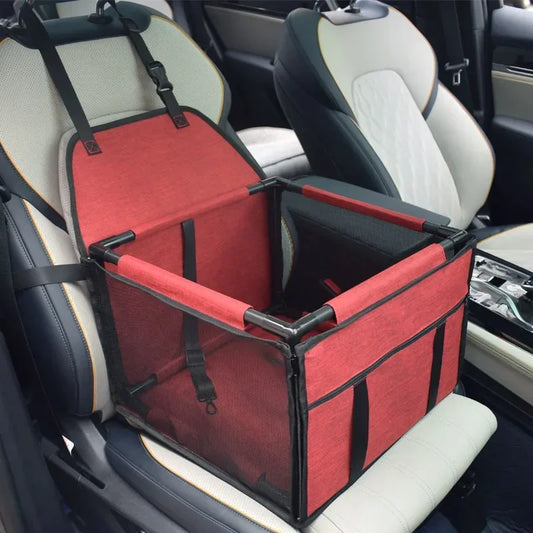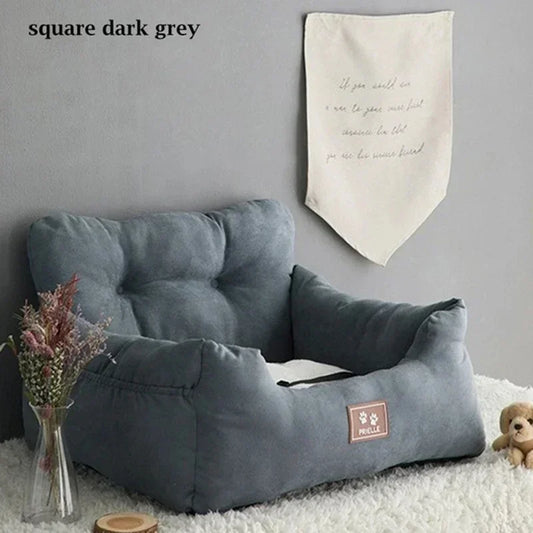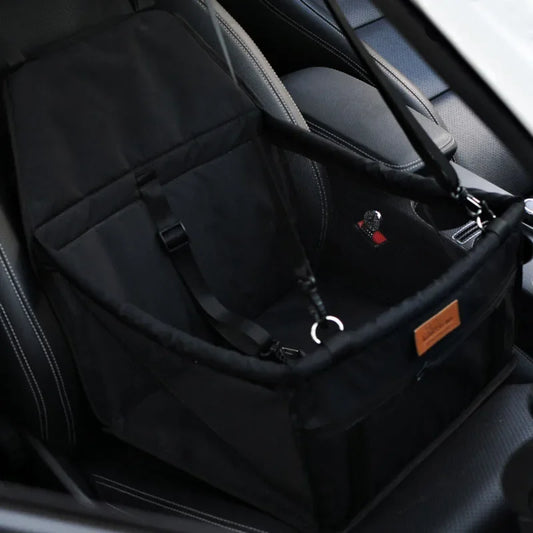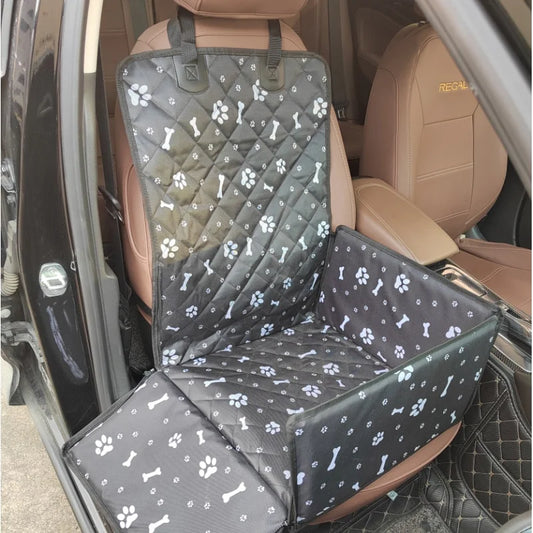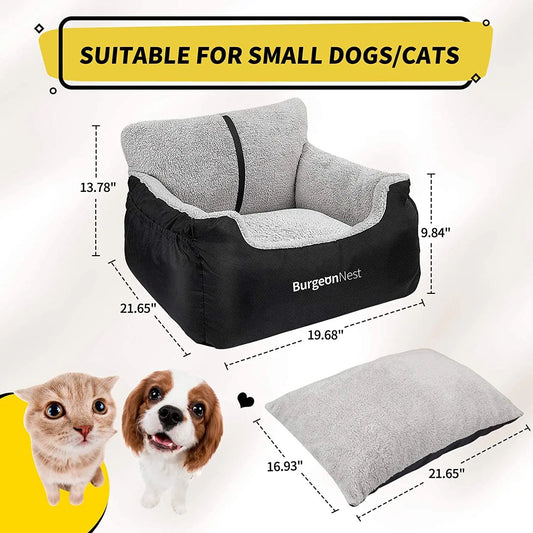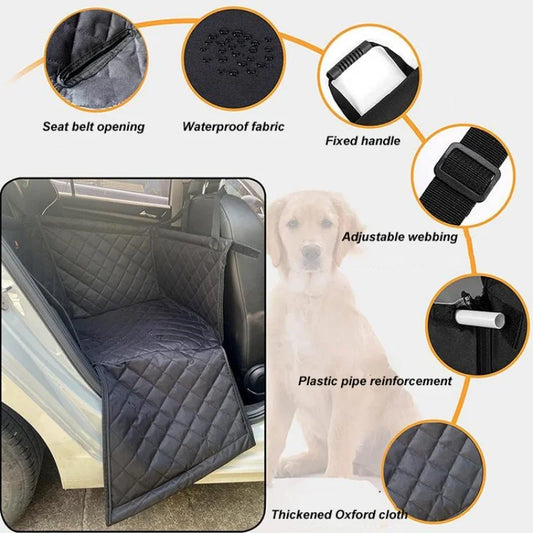Collection: Dog Car Seats
🚗 Dog Car Seats – Safe, Comfy & Travel-Ready for Your Pup! 🐶
Keep your furry friend secure and cozy on every car ride with our Dog Car Seat collection! Designed for safety, comfort, and mess-free travel, these pet seats prevent sliding, reduce anxiety, and protect your car from fur and dirt.
✅ Secure & Stable Fit | ✅ Soft & Cozy Padding | ✅ Waterproof & Easy to Clean
From portable carriers to plush travel beds, we have the perfect Dog Car Seat for your pup’s needs. Give your pet the ultimate travel comfort—shop now and ride stress-free! 🛒🐾✨
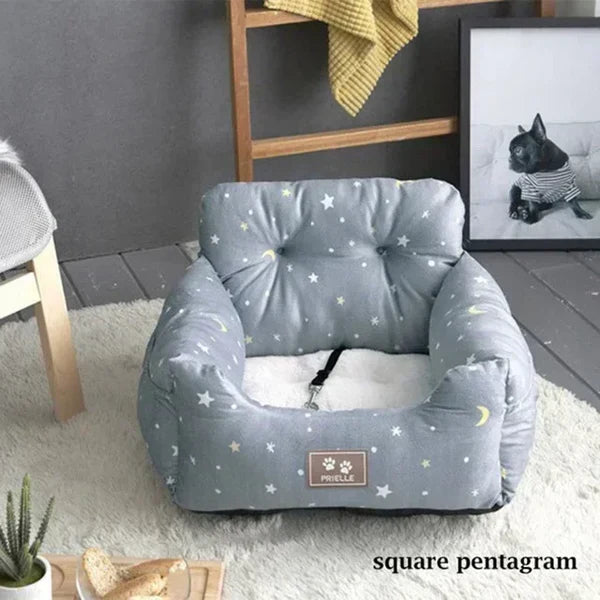
Shop by Category
- All
- Outdoor Dog Beds
- Raised Dog Beds
- Memory Foam Dog Beds
- Orthopedic Dog Beds
- Large Dog Beds
- Waterproof Dog Beds
- Dog Bed Covers
- Dog Beds for Small Dogs
- Washable Dog Beds
- Dog Blankets
- Dog Car Beds
- Chew Proof Dog Beds
- Cooling Dog Beds
- Human Dog Beds
- Dog Camping Beds
- Dog Car Hammock
- Dog Car Seat Covers
- Dog Car Seats
- Dog Trampoline Beds
- Dog Sofa Beds
- Dog Swag
-
Waterproof Dog Car Seat Car Sofa Bed Cushion for Dogs and Cats
Free ShippingRegular price From $84.95 AUDRegular priceUnit price / perSale price$131.95 AUDFrom $84.95 AUDSale -
Pet Car Seat Luxury Faux Leather for Dog Cat Car Travel Bed
Free ShippingRegular price From $109.95 AUDRegular priceUnit price / perSale price$153.95 AUDFrom $109.95 AUDSale -
Travel Dog Car Seat Cover Bag
Free ShippingRegular price From $58.95 AUDRegular priceUnit price / perSale price$82.95 AUDFrom $58.95 AUDSale -
Pet Car Seat Bed Travel Sofa Bed
Free ShippingRegular price $93.95 AUDRegular priceUnit price / perSale price$152.95 AUD$93.95 AUDSale -
Pet Car Seat Bag Double Thick
Free ShippingRegular price From $33.95 AUDRegular priceUnit price / perSale price$42.95 AUDFrom $33.95 AUDSale -
Dog Carrier Car Seat Cover Bed
Free ShippingRegular price From $50.95 AUDRegular priceUnit price / perSale price$79.95 AUDFrom $50.95 AUDSale -
Dog Car Seat for Small Dog Waterproof
Free ShippingRegular price $70.95 AUDRegular priceUnit price / perSale price$114.95 AUD$70.95 AUDSold out -
Dog Car Carrier Bed Waterproof Hammock
Free ShippingRegular price From $56.95 AUDRegular priceUnit price / perSale price$91.95 AUDFrom $56.95 AUDSale
Dog Car Seats – The Ultimate Comfort & Safety for Your Pet on the Road 🚗🐶
Keep Your Dog Safe, Secure & Comfortable on Every Ride
Looking for dog car seats that provide superior safety, comfort, and protection for your furry friend? Our premium collection of travel-friendly dog car seats ensures that your pet enjoys a secure and cozy ride while keeping your car clean and mess-free. Whether you’re heading on a road trip or running daily errands, a dog car seat is an essential investment in your pet’s safety and well-being.
✅ Why Choose Our Dog Car Seats?
1. Ultimate Safety & Stability for Stress-Free Travel
- Prevents sliding & sudden movements with secure straps and a non-slip base.
- Built-in clip-on leash keeps your dog safely in place.
- Elevated designs provide a better view, reducing travel anxiety.
2. Plush Comfort to Keep Your Pet Relaxed
- Soft, cushioned interiors create a cozy space for your dog to snuggle.
- Helps reduce motion sickness and anxiety on long car rides.
- Designed for small and medium-sized dogs, providing just the right amount of support.
3. Waterproof & Easy-to-Clean Materials
- Waterproof and scratch-resistant fabric protects your car from dirt, fur, and spills.
- Machine-washable liners make maintenance effortless.
- Resistant to odor buildup, keeping your car fresh and clean.
4. Convenient Storage & Space-Saving Design
- Built-in pockets to store treats, leashes, toys, and travel essentials.
- Foldable & lightweight, making it easy to carry and store when not in use.
- Universal fit for most vehicles, including sedans, SUVs, and trucks.
5. Designed for Road Trips, Daily Drives & Outdoor Adventures
- Perfect for short commutes, long road trips, and weekend getaways.
- Provides a safe, enclosed space that keeps your pet secure in case of sudden stops.
- Great for pets who love to ride but need extra support and protection.
🚚 Free Shipping on All Dog Car Seats – Order Today!
Upgrade your pet’s travel experience with our top-rated dog car seats. Give them the safety, comfort, and elevated view they deserve while protecting your car from messes.
👉 Shop Now & Travel Worry-Free with Your Furry Friend! 🛒🐾✨
Dog Car Seats FAQs – Find the Perfect Travel Solution at PetCareShed 🚗🐶
At PetCareShed, we understand that pet safety and comfort are top priorities when traveling. Our dog car seats are designed to provide the ultimate security, support, and convenience for both you and your furry companion. Below, we answer some of the most common questions pet owners in Australia ask before purchasing a dog car seat.
1. What Are the Safest Dog Car Seats Available in Australia?
At PetCareShed, safety is our top priority. Our dog car seats are engineered with secure straps, anti-slip bases, and clip-on leashes to keep your pet safely in place during car rides. Here’s what makes our collection the safest choice:
- Built-in Safety Leash – Keeps your dog secure and prevents jumping.
- Adjustable Car Straps – Attach to the headrest or seatbelt for a snug fit.
- Non-Slip Bottoms – Prevents sliding or tipping over on sudden stops.
- High-Wall & Enclosed Designs – Creates a protective space for your pet.
Looking for crash-tested dog car seats? Our premium selection includes reinforced, durable options that ensure maximum safety on Australian roads.
2. How Do I Choose the Right Size Dog Car Seat for My Breed?
Finding the perfect fit for your dog is essential for comfort and security. At PetCareShed, we offer a size guide on each product page to help you choose the right dog car seat based on your pet’s weight and dimensions. Here’s a quick breakdown:
- Small Dog Car Seats (Up to 7 kg) – Ideal for Chihuahuas, Toy Poodles, and Yorkies.
- Medium Dog Car Seats (7-15 kg) – Perfect for Cocker Spaniels, Pugs, and French Bulldogs.
- Large Dog Car Seats (15 kg+) – Designed for Border Collies, Labradors, and similar-sized breeds.
Need help? Contact our team, and we’ll assist you in selecting the perfect size for your pup!
3. Where Can I Buy High-Quality Dog Car Seats in Australia?
Right here at PetCareShed! 🐾 We are one of Australia’s leading pet supply stores, offering a wide range of premium dog car seats that combine safety, durability, and comfort.
Why shop with us?
✔️ Australian-Based Store – Fast shipping across Australia.
✔️ Curated, High-Quality Products – We handpick only the best dog car seats.
✔️ Affordable Prices & Exclusive Deals – Get premium quality without breaking the bank.
✔️ Customer Satisfaction Guarantee – Trusted by Australian pet owners.
🛒 Shop now and give your furry friend a safer, more comfortable ride!
4. What Features Should I Look for in a Dog Car Seat to Ensure Comfort and Safety?
A dog car seat should do more than just secure your pet—it should provide a comfortable, stress-free travel experience. Here’s what makes our dog car seats at PetCareShed stand out:
✔️ Plush, Soft Interiors – Provides a cozy, nest-like feel to keep your pet calm.
✔️ Waterproof & Easy-to-Clean Materials – Shields against dirt, fur, and spills.
✔️ Adjustable Security Straps & Safety Leash – Prevents movement while driving.
✔️ Breathable Mesh Windows – Improves airflow and reduces overheating.
✔️ Compact & Portable Designs – Foldable and lightweight for easy storage.
We have a variety of dog car seats to suit different needs—whether you need a booster seat, hammock-style cover, or a soft, cushioned nest for long road trips!
5. Are There Dog Car Seats That Double as Carriers for Easy Transport?
Yes! At PetCareShed, we offer multi-functional dog car seats that double as travel carriers for your convenience. These convertible dog car seats allow you to:
🚗 Use It as a Secure Car Seat – Attach to your car seat for a safe, stress-free ride.
🐶 Carry Your Pet Easily – Remove from the car and use it as a travel carrier.
🏡 Use It as a Cozy Indoor Bed – Perfect for home relaxation after a trip.
Many of our dog car seats come with handles, storage pockets, and reinforced padding, making them perfect for travel, vet visits, and outdoor adventures.
Blog posts
View all-

Meet the Norwegian Lundehund: Australia’s Rares...
The Norwegian Lundehund stands as one of the most distinctive and seldom-seen dog breeds in Australia. With its roots stretching back to the rugged coastal cliffs of Norway, this breed...
Meet the Norwegian Lundehund: Australia’s Rares...
The Norwegian Lundehund stands as one of the most distinctive and seldom-seen dog breeds in Australia. With its roots stretching back to the rugged coastal cliffs of Norway, this breed was once relied upon by Scandinavian fishermen for its remarkable ability to scale steep rocks and retrieve puffins—a vital source of food. What sets the Lundehund apart from every other breed is its remarkable anatomical adaptations: six toes on each foot, double-jointed flexibility, and the capacity to close its ears to protect against water and debris.
-

Best Collars for Dogs That Pull: Vet-Approved P...
Key Takeaways Dogs that pull on the lead may suffer from neck strain or behavioural issues if the wrong collar is used. Vet-approved collars like martingales and head halters offer...
Best Collars for Dogs That Pull: Vet-Approved P...
Key Takeaways Dogs that pull on the lead may suffer from neck strain or behavioural issues if the wrong collar is used. Vet-approved collars like martingales and head halters offer more humane and effective control. Tools alone don’t solve pulling — they must be used with proper training and positive reinforcement. Australian pet owners should be aware of state-specific laws around the use of corrective collars like prong or shock collars. Choosing the right collar depends on your dog’s size, strength, and temperament — and not all collars work for every dog. This guide helps you understand which collars are safest, most effective, and recommended by Australian vets and trainers. Introduction Pulling on the lead is one of the most common complaints from dog owners. Whether it’s a young puppy excited to explore the world or a large dog that simply doesn’t know how strong it is, leash pulling can make daily walks stressful — even dangerous. For Australian pet owners, especially those walking in busy suburbs, parks, or bushland trails, having control of your dog is essential. But the solution isn't just about brute strength — it’s about choosing the right tools that promote comfort, safety, and better behaviour. In this article, we explore the best collars for dogs that pull — those recommended by veterinarians and animal behaviour experts — and explain how to use them effectively. We'll also guide you through what to avoid, what the law says in Australia, and how to pair the right collar with proven training techniques. Why Dogs Pull on the Leash Understanding why your dog pulls is the first step in fixing it. Contrary to popular belief, pulling isn’t necessarily about dominance or defiance. It’s often more about excitement, poor leash manners, or a simple case of what gets rewarded, gets repeated. Common Reasons Dogs Pull: Excitement or overstimulation: New smells, sights, and sounds make walks thrilling. Lack of early leash training: Dogs not trained as pups may never learn proper walking etiquette. Reinforced pulling: If pulling gets your dog where it wants to go, it learns to repeat it. Breed traits: Working breeds like Huskies, Staffies, and Kelpies often pull more due to strong drive. Infrequent walking: Dogs that only walk occasionally tend to be more energetic and harder to manage on leash. 🗨️ “Dogs pull because it works. If they get to a smell or a person faster, the behaviour is reinforced.” — Dr. Kate Mornement, Australian Animal Behaviourist Risks of Using the Wrong Collar on a Dog That Pulls Using an inappropriate collar on a pulling dog isn’t just ineffective — it can be harmful. Pulling with a regular flat collar or choke chain can result in long-term damage or distress. Potential Risks Include: Neck strain and tracheal injury: Especially dangerous for small breeds and brachycephalic dogs. Increased anxiety or aggression: Painful collars can create negative associations with walking. Escape risk: Some collars are easier for dogs to slip out of when pulling. Legal implications: Certain collars, like prong and shock collars, are regulated or banned in parts of Australia. ⚠️ According to the RSPCA, aversive training tools like choke or prong collars “can cause pain and fear, and may lead to increased aggression and behavioural issues.” (source). What Vets Recommend: Principles Behind Safe Collar Use Veterinarians and animal behaviourists emphasise humane training tools that promote trust and reduce stress. This aligns with what’s known as "force-free training", which avoids pain or intimidation. Key Principles Vets Emphasise: Use collars that minimise pressure on the neck. Ensure the collar fits properly — not too tight, not too loose. Choose materials that don’t cause rubbing or irritation. Combine tools with positive reinforcement (treats, praise). Transition to simpler collars as the dog becomes better trained. 🗨️ “The most effective tools are the ones that make walking a positive experience for both dog and owner.” — Dr. Cam Day, Veterinary Behaviourist (Australia) Top Vet-Approved Collars for Dogs That Pull Not all collars are created equal. Below are the top types of collars (and alternatives) that vets and trainers frequently recommend. 1. Martingale Collars Also called limited-slip collars, martingales tighten slightly when the dog pulls — but without the harsh “choking” action of a traditional slip lead. Best For: Dogs with narrow heads (e.g., Greyhounds, Whippets) Dogs that slip out of flat collars Pros: Offers gentle correction Prevents slipping out Recommended by behaviourists Cons: Still applies pressure to neck — not suitable for heavy pullers ✅ RSPCA Australia supports martingale collars as a safer option for dogs that pull, especially when used alongside training. 2. Head Collars (e.g., Halti, Gentle Leader) These collars fit around the dog's snout and gently guide the head — and therefore the body — making pulling less effective. Best For: Large, strong dogs Reactive dogs needing more directional control Pros: Immediate reduction in pulling Helps prevent lunging Cons: Some dogs resist wearing it at first Requires acclimation and proper fit 🗨️ “Used correctly, head halters can be highly effective. But misuse can cause neck strain, so training is essential.” — Dr. Jo Righetti, Pet Behaviour Consultant 3. Front-Clip Harnesses (Not collars, but often preferred) Harnesses like the PetSafe Easy Walk or Rogz Control Harness offer an alternative by redistributing pressure across the dog’s chest rather than its neck. Best For: Dogs that pull heavily or have respiratory issues Owners who struggle with leash strength Pros: Safer than collars for heavy pullers Reduces pulling through redirection Popular in Australian obedience circles Cons: Can cause rubbing if poorly fitted May not deter very determined pullers 🐾 Note: In many Australian vet clinics, front-clip harnesses are the go-to recommendation for large breeds and rescue dogs. 4. Flat Collars (for well-trained dogs only) Simple and comfortable, these collars are suitable once your dog is trained to walk calmly. Best For: Dogs with reliable leash manners Everyday ID tag wear Caution: Never rely on a flat collar alone if your dog is still learning not to pull. Collars to Avoid for Pulling Dogs Some collar types are outdated, inhumane, or outright dangerous — especially when used incorrectly. 1. Choke Chains Designed to tighten around the neck when the dog pulls. Once popular, now widely criticised. ❌ “We do not recommend choke chains under any circumstances.” — Australian Veterinary Association 2. Prong Collars Metal collars with inward-facing prongs that dig into the skin when pulled. Banned in Victoria and under review in other states. May cause behavioural fallout, fear, and aggression. ⚠️ The RSPCA and Pet Industry Association of Australia oppose their use. 3. Shock Collars (E-collars) These collars deliver electric stimulation to “correct” behaviour. Legal status varies across Australia (banned in some states). Not recommended by any major Australian veterinary body. “Using pain to control behaviour is not only unethical — it doesn’t work long-term.” — Dr. Katrina Warren, TV vet and author Choosing the Right Collar: What to Consider Every dog is different, and the best collar for one may not be suitable for another. To select the right collar for a dog that pulls, you’ll need to assess their physical characteristics, behaviour, and environment. Factors to Consider: Size and Breed Smaller breeds (e.g., Maltese, Cavoodles) may need softer materials and minimal pressure around the neck. Larger or working breeds (e.g., Kelpies, Labradors) may benefit from front-clip harnesses or head collars due to stronger pulling. Pulling Intensity Mild pullers might do well with a martingale. Strong pullers may require a head halter or harness for safe control. Temperament Anxious or nervous dogs may become reactive with restrictive collars. Confident dogs may test limits and need something more secure. Walking Environment Suburban footpaths vs bush trails vs beach walks—some collars handle moisture or rough terrain better. Training Level Dogs early in training need more control. Trained dogs may graduate to a padded flat collar. How to Fit a Collar Properly Poor fit is a common issue that can make even the safest collar ineffective—or harmful. General Fitting Guidelines: The 2-Finger Rule: You should be able to slide two fingers comfortably between the collar and your dog’s neck. Measure Before You Buy: Use a soft measuring tape to measure your dog’s neck at its base. Watch for Signs of Discomfort: Rubbing or hair loss Coughing or gagging on walks Frequent pawing at the collar Slipping out or constant re-adjustment Tips for Head Collars and Harnesses: Ensure the nose loop (for head collars) isn’t too tight — your dog should be able to open their mouth. Chest harnesses should sit snugly on the breastbone, not press against the armpits. 🗨️ “A poor-fitting collar can lead to discomfort, skin damage, or worse — especially for dogs that pull hard.” — Dr. Melissa Meehan, Vet & Behavioural Consultant Training Tips for Dogs That Pull A collar is just a tool. To see lasting results, pair it with consistent training that encourages your dog to walk calmly on a lead. Foundational Training Techniques: Reward-Based Walking: Reward your dog with treats or praise when they walk beside you without pulling. Stop walking immediately when they pull — teach them pulling gets them nowhere. Redirection: Use a cue like “Let’s go!” and change direction often to keep your dog focused. Short, Frequent Walks: Consistency is better than duration. Several short walks help reinforce good habits. Engage a Certified Trainer: Seek a professional who uses positive reinforcement methods. Avoid trainers who rely on punishment-based tools like prong or shock collars. 🔗 For trainer directories, visit: Delta Institute (Australia) or PPGA Australian Perspective: What Local Vets and Laws Say Australia has some of the strictest animal welfare laws in the world, particularly concerning aversive training tools. Legal Status of Collars in Australia (as of 2025): Prong Collars: Banned in VIC; under review in NSW and ACT. Shock Collars: Banned in parts of SA and WA. Choke Chains: Not illegal but strongly discouraged by vets and the RSPCA. Martingale, Head Collars, and Front-Clip Harnesses: Fully legal and recommended. Trusted Brands Available in Australia: Rogz Utility Control Collar (available at PetCareShed) Halti Optifit Headcollar PetSafe Easy Walk Harness Black Dog Wear Training Gear (Australian-made) 🗨️ “Responsible collar use means choosing what’s humane and effective. Australia leads the way with a shift to force-free training methods.” — Association of Pet Dog Trainers Australia Expert Commentary and Vet Insights Multiple Australian professionals advocate for smarter collar choices based on evidence, not tradition. 🗨️ “We’re seeing a move away from force-based collars in vet clinics. Behavioural injuries are real, and prevention starts with the right gear.”— Dr. Bronwyn Hodgson, Sydney Animal Hospital 🗨️ “Using a collar that aligns with how a dog thinks and learns is more powerful than forcing control.”— Stephanie McColl, Delta Accredited Trainer, Melbourne 🗨️ “Insurance claims related to neck injuries are rising in dogs that wear outdated collars. Choose gear that protects, not punishes.”— PetSure Australia 2024 Industry Report Related Products from PetCareShed At PetCareShed, we stock safe and trusted collars recommended by vets and trainers: Rogz Control Collar with Locking Buckle Halti Headcollars and Training Leads PetSafe Easy Walk Harness – Front Clip Martingale Training Collars in Soft Nylon Comfort-Fit Flat Collars for Trained Dogs ✅ Free shipping across Australia💬 Need help choosing? Contact our product specialists. Frequently Asked Questions Are no-pull collars safe for puppies? Yes, many are — especially front-clip harnesses and head halters. Always introduce them slowly and pair with positive training. What if my dog still pulls with a no-pull collar? Consider a professional trainer. No collar will work without consistent reinforcement and behaviour shaping. Can I use a training collar with a retractable leash? It’s not recommended. Retractable leashes encourage pulling and reduce your control — especially with corrective tools. How long does it take to train a dog to stop pulling? This depends on age, breed, and consistency. Some dogs respond in days, others may take weeks to months of practice. Are head halters cruel or uncomfortable? Not when fitted properly. They’re like a horse halter — they guide, not punish. Always supervise use.
-

Abyssinian Cats: Active and Intelligent Felines
The Abyssinian cat is a breed that captivates hearts and minds alike, known for its remarkable intelligence, boundless energy, and striking appearance. Often described as the "athlete" of the feline...
Abyssinian Cats: Active and Intelligent Felines
The Abyssinian cat is a breed that captivates hearts and minds alike, known for its remarkable intelligence, boundless energy, and striking appearance. Often described as the "athlete" of the feline world, the Abyssinian is more than just a pretty face; it is a companion that brings adventure, joy, and a touch of the exotic into the homes of Australian pet lovers.






